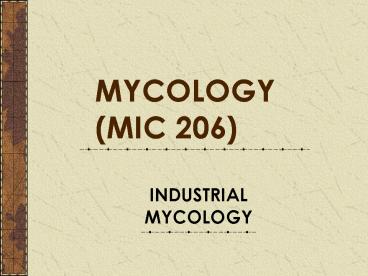INDUSTRIAL MYCOLOGY - PowerPoint PPT Presentation
1 / 22
Title:
INDUSTRIAL MYCOLOGY
Description:
MYCOLOGY (MIC 206) INDUSTRIAL MYCOLOGY FOOD AND BEVERAGES INDUSTRIES Food and Beverages Industry Brewer s yeast S. cerevisiae ferments sugars in cereal grains to ... – PowerPoint PPT presentation
Number of Views:396
Avg rating:3.0/5.0
Title: INDUSTRIAL MYCOLOGY
1
MYCOLOGY (MIC 206)
- INDUSTRIAL MYCOLOGY
2
FOOD AND BEVERAGES INDUSTRIES
3
Food and Beverages Industry
- Brewers yeast
- S. cerevisiae ferments sugars in cereal grains
to produce - alcohol
- beers and lagers.
- Citric acid
- used in soft drinks, candies, artificial lemon
juice, baked goods etc. - produced industrially by fungus fermentation
using Aspergillus niger. - Minor fraction is produced by Yarrowia
lipolytica.
4
Food and Beverages Industry
- Soya sauce
- used as condiments, colorouring and flavouring
agents. - Aerobic fermentation involving Aspergillus oryzae
or A. sojae. - Tempe
- Involves fermentation of cooked whole or dehulled
soya beans by Rhizopus species (R.oigosporus). - The resulting cake-like product can be cut into
cubes and fried or cooked with other ingredients.
5
Baking Industry
- Bakers yeast
- S.cerevisiae) ferment sugars in the flour,
releasing CO2. - ? makes bubbles in the dough and causes the
dough to rise (increase in volume). - used in the leavening of bread and other baked
products. - The alcohol produced evaporates during baking.
- Cheese Ripening
- The blue mould, Penicillium, is used in the
ripening process to prepare speciality cheeses
such as - blue cheeses e.g. Roquefort, Gorgonzola, Stilton
etc. - soft cheeses such as Camembert and Brie.
6
Mycoprotein - Quorn
- 1960s, mycoprotein was developed by Rank Hovis
and McDougall. - 1986, manufactured and marketed under the name of
Quorn by Marlow Foods Ltd (named after the area
of its discovery). - extracted from a Fusarium venenatum.
- Used as a health food and an alternative to meat.
- found to be very nutritious, not least because it
contains high quality protein and fibre, but is
also low in fat. - leading brand of mycoprotein food product in the
UK and Ireland.
7
MEDICINE
8
Antibiotics - Penicillin
- discovered in 1929 by Sir Alexander Fleming, who
observed inhibition of staphylococci on an agar
plate contaminated by a Penicillium mold. - He noticed that a patch of the mold Penicillium
notatum had grown on a plate containing the
bacterium Staphylococcus and that around the mold
there was a zone where no Staphylococcus could
grow. - After more research, he was able to show that
culture broth of the mold prevented growth of the
Staphylococcus even when diluted up to 800 times.
- He named the active substance penicillin but was
unable to isolate it.
9
Antibiotics - Penicillin
- Other examples of antibiotics derived from fungi
- Cephalosporin (Cephalosporium sp).
- Griseofulvin (Penicillium griseofulvum and
Penicillium patulum).
10
Statins
- Statins (or HMG-CoA reductase inhibitors) are a
class of drugs used to lower cholesterol levels .
- Are products of metabolic reactions in fungi.
- Lovastatin Aspergillus terreus strains.
- Mevastatin Penicillium citrinum.
- Functions inhibit an enzyme HMG-CoA reductase,
which plays a central role in the production of
cholesterol in the liver. - involved in the synthesis of cholesterol levels
in cardiovascular (CVD) patients.
11
Immuno-suppressives
- Immune suppressants are essential for organ
transplant patients. - The T cells of the human immune system recognise
the new organ as foreign and began to destroy
the organ. - Cyclosporin A, produced by Tolypocladium inflatum
(Filamentous fungus). - This drugs prevents organ rejection by inhibiting
T-cell activation.
12
Vitamins
- All fungi are a good source of vitamins.
- Ex Brewers Yeast (synthesized B group
vitamins). - In industry, Fungi Nematospora gossypii and
Eremothecium ashbyi used to produced B-
vitamins.
13
ENERGY PRODUCTION
An endophytic fungi, that lives within a plant,
churns out mycodiesel.
14
Mycodiesel
- volatile organic products made by fungi that have
fuel potential. - The latest discovery is that of an endophytic
Hypoxylon/Nodulosporium species, or one that
lives within a plant, that makes the compound
cineole along with a number of other cyclohexanes
(colorless, flammable liquids found in petroleum
crude oil and volcanic gases) and compounds with
enormous fuel potential. - Cineole is of special interest since it has been
shown that it can be added to gasoline at a ratio
of 8 parts cineole to 1 part of gasoline, ending
up with a final octane rating of 95.
15
CROP IMPROVEMENT
16
Crop Improvement
- The most important fungi in crop production is
Mycorrhizal. - Form symbiotic relationship with the legumious
plant.
17
Image of mycorr greenhouse
18
Preparing the mycelium for seed inoculation at
the University of Namibia
19
Ideal houses for mycelium and mushroom growth
Namibia
20
Mycelium development fruiting bodies
21
WASTE TREATMENT
22
Fungi in Waste Treatment
- Fungi such as Aspergillus niger and Chaetomium
cupreum have also been used to reduce the content
of highly toxic tannins in tannery effluents. - Penicillium sp. can also be used to coagulate
bread yeast suspensions, and to degrade heavily
coloured olive oil effluents to low molecular
weight polyphenols. - Aspergillus oryzae remove the highly coloured
product melanoidin from liquid molasses wastes































